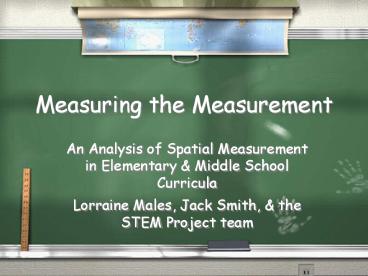Measuring the Measurement - PowerPoint PPT Presentation
Title:
Measuring the Measurement
Description:
Measuring the Measurement An Analysis of Spatial Measurement in Elementary & Middle School Curricula Lorraine Males, Jack Smith, & the STEM Project team – PowerPoint PPT presentation
Number of Views:803
Avg rating:3.0/5.0
Title: Measuring the Measurement
1
Measuring the Measurement
- An Analysis of Spatial Measurement in Elementary
Middle School Curricula - Lorraine Males, Jack Smith, the STEM Project
team
2
Session Overview
- Introductions
- Brief presentation of STEM results for length,
K3 (Jack) - Questions about the presentation
- Discussion about your teaching measurement
(Lorraine)
3
Introducing yourself
- Your name, school, community
- Your teaching assignment for 2008-09
- Your math curriculum (textbook)
- Do you teach measurement of length, area, and/or
volume?
4
Thought Question 1
- How do you feel about your current texts
approach to measurement? - Are you happy with it?
5
Thought Question 2
- Do you consider teaching measurement a challenge?
- Why (or why not)?
6
Thought Question 3
- Have there been times when teaching measurement
has gone really well? - If so, what made it work out well
- (in your view)?
7
Thought Question 4
- What do you look for as indicators that your
students understand measurement?
8
What is STEM?
- Strengthening Tomorrows Education in Measurement
- A very careful examination of the spatial
measurement content of 3 elementary 3 middle
school curricula - Do our present texts provide students with
sufficient opportunity to learn measurement?
9
Why do this?
- Measurement is important mathematics
- Our students dont show they know /understand
what we want them to - Textbooks are important, for both students and
teachers - Deficits there would be hard to fix
10
Just a bit on Understanding
- A National Assessment (NAEP) item How long is
the toothpick? - Choices 2.5 inches 8 inches 10.5 inches 3.5
inches - 2025 of U.S. 4th graders and 60 of U.S. 8th
graders answer correctly - 20 of 8th graders answer 3.5 inches
11
Which Curricula?
- Elementary
- Everyday Mathematics (Standards-based)
- Scott-Foresman/Addison-Wesleys Mathematics
(publisher-developed) - Saxon Mathematics (different from both)
- Middle School
- Connected Mathematics Project
- Glencoes Mathematics, Concepts Applications
- Saxon Mathematics
12
Coding Measurement Knowledge
- Count all instances of three different kinds of
knowledge - Conceptual (basic principles)
- Procedural (measurement processes)
- Conventional (notations tools)
- Watch for how knowledge is expressed (e.g.,
statements vs. questions)
13
Focus on Length
- Completed the analysis of Grades K-3
- This is where the foundation of length is
presented (and learned?) - Our focus today will be on the holes we have found
14
A Common Procedural Focus
- Procedural percentages (of all elements)
- K 82 (EM) 98 (SFAW) 95 (Saxon)
- Grade 1 78 (EM) 78 (SFAW) 91 (Saxon)
- Grade 2 88 (EM) 84 (SFAW) 86 (Saxon)
15
What is Missing?
- Unit iteration (a conceptual element)
- You have a length unit
- You move it (iterate it) along the object
- You count units (to accumulate distance)
- Our phrasing Measures of length are produced by
iterating a length unit from one end of an
object, segment, or distance to the other and
then counting the number of iterations. Iterated
units may not overlap or leave gaps.
16
What is Missing? (cont.)
- Why is Unit Iteration important?
- Not clear that students understand how rulers are
tools that iterate units for them - Remember the broken ruler problem
17
Examples of Unit Iteration
- See the sheet of examples
- Most examples are partial have gaps
- Key missing element motion unit sweeping
through the object or distance
18
Frequencies of Unit Iteration
- Not many total instances
- Half (n 9) are partial statements
- Disappointing drop off in Grade 2
19
Closing
- Questions???
- Well be back next year with more results (e.g.,
area, primary grades) - If you are interested in this work, we would
like to work with you - E-mails maleslor_at_msu.edu (Lorraine)
jsmith_at_msu.edu (Jack)































